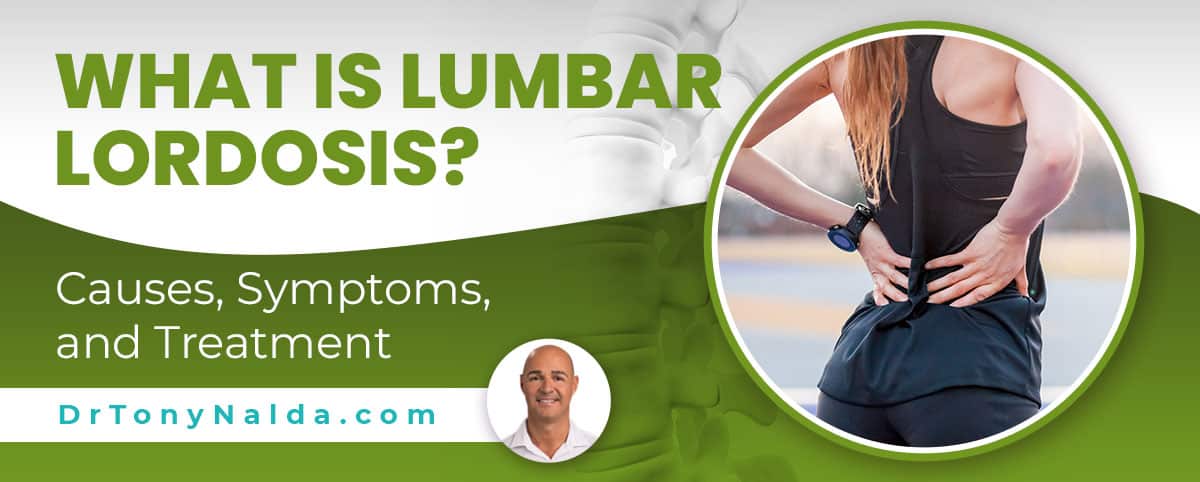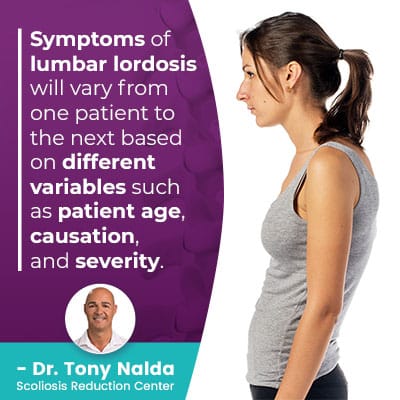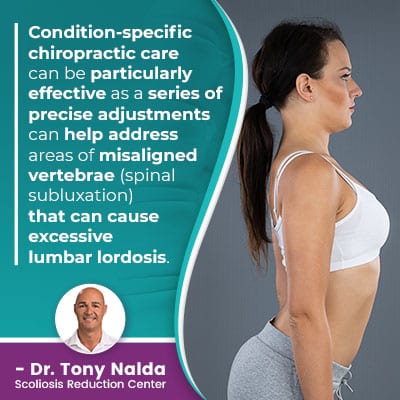What Is Lumbar Lordosis? Causes, Symptoms, and Treatment

The spine’s natural and healthy curves make it stronger, more flexible, and better able to absorb stress, like a coiled spring. There are a number of spinal conditions a person can develop that involve a loss of the spine’s healthy and natural curves, and lumbar lordosis, also known as hyperlordosis of the lumbar spine, is one of them.
There are three main sections of the spine, and each spinal section has its own characteristic curvature type. Lordosis refers to the spine’s inward curves at the lumbar and cervical levels, so lumbar lordosis is referring to the lower back’s inward curvature.
Before getting to the specifics of lumbar lordosis, let’s talk about the difference between a healthy spinal curve and an unhealthy one.
Table of Contents
The Spine’s Healthy Curves
A healthy spine viewed from the front or back will appear straight and, when viewed from the sides, will take on a soft ‘S’ shape: showing that the spine has natural and healthy curves.
The spine’s healthy curves make it stronger and more flexible and facilitate its even absorption/distribution of mechanical stress incurred during movement.
So in order for the spine to function optimally, it has to maintain its natural curvatures and alignment.
When a healthy spine is aligned, this means its vertebrae (bones) are stacked on top of one another in a straight and neutral alignment, but if an unnatural spinal curve develops, this means the vertebral bodies have shifted their position, and this disrupts the biomechanics of the entire spine.
What is Lumbar Lordosis?
As mentioned, there are three main spinal sections: cervical (neck), thoracic (middle/upper back), and lumbar (lower back).
The spine has different types of natural and healthy curves, those that bend inward toward the body’s center in a standard ‘C’ shape and those that bend outward, away from the body’s center, in a reverse ‘C’ shape.
Lordosis refers to the spine’s natural inward curves that are found in the cervical and lumbar spinal sections, and kyphosis refers to the outward curve found in the thoracic section of the spine.
Lumbar lordosis refers to the natural curvature of the lower spine, but when it becomes exaggerated or straightened, causing symptoms like back curvature, understanding what lumbar lordosis means and how to correct it becomes essential, especially for those diagnosed with severe lordosis seeking treatment options to correct the condition.
There is a natural curvature-degree range of lordosis and kyphosis, and if a person’s curvature degree falls within a normal spine range, the curve is a healthy one, but if a person’s lordosis or kyphosis falls beyond a normal range, problems can occur.
Healthy spines have a cervical lordosis range of between 20 and 40 degrees, and a healthy range of lumbar lordosis would fall between 40 and 60 degrees; a healthy range of thoracic kyphosis would fall within a 20-to-40-degree range.
So lumbar lordosis refers to the spine’s inward curvature of the lower back. If that curve becomes excessive, it can disrupt the biomechanics of the entire spine; the health of each spinal curve is dependent on the others.
Lumbar lordosis, a term used to describe the natural inward curve of the lower spine, has a normal lumbar lordosis that provides support. However, severe lordosis treatment may require therapies to address issues such as lumbar lordosis straightening and diagnosis.
Lumbar lordosis, characterized by an exaggerated inward curve of the lower spine, is a condition often diagnosed through a lordosis definition and can develop due to various causes. Understanding how to fix hyperlordosis which is an excessive lumbar lordosis is essential for addressing the associated symptoms and choosing the appropriate treatment methods to alleviate discomfort and improve spinal alignment.
So, let’s talk about the symptoms that can accompany lumbar lordosis.
Symptoms of Lumbar Lordosis
 Symptoms of lumbar lordosis will vary from one patient to the next based on different variables such as patient age, causation, and severity.
Symptoms of lumbar lordosis will vary from one patient to the next based on different variables such as patient age, causation, and severity.
Hyperlordosis is often called swayback, based on the appearance it gives the body; the excessive inward curve of the lower back causes the buttocks and abdomen to protrude excessively.
In addition to giving the body a swayback appearance, additional lumbar lordosis symptoms can include:
- An inability to lay flat on the floor with the lower back in contact with the floor
- Varying levels of back pain
- Varying levels of muscle pain
- Mobility issues
- Sciatica pain felt in the legs and feet
The degree of nerve involvement is a key factor in the types of symptoms spinal conditions can cause, and when it comes to lumbar lordosis, this is why sciatica pain can be a complication. The sciatic nerve starts in the lower back and extends down the buttock, back of the leg, and into the foot.
If the lumbar spine has developed an unnatural spinal curve (excessive lordosis), it introduces uneven forces to the spine and its surrounding muscles and nerves, and if the sciatic nerve is exposed to uneven pressure, it can become irritated, inflamed, compressed, or impinged.
So now that we’ve defined the condition and explored some of its common symptoms let’s move on to the topic of causation.
Causes of Lumbar Lordosis
The lumbar spine has to support the weight of the entire spine above, as well as the trunk, and it also feels the effects/strain of bending, twisting, and lifting motions, which is why it’s estimated that approximately 80 percent of people will struggle with lower back pain at some point in their lives.
Most lumbar lordosis causes are idiopathic, meaning we don’t know what causes the condition to develop. There are also different types of lumbar lordosis: postural lumbar lordosis, traumatic lumbar lordosis, congenital lumbar lordosis, and more.
There are, however, some known causes for lumbar lordosis, including lifestyle issues such as carrying excess weight and chronic poor posture, and excessive kyphosis in the thoracic spine; when an unnatural spinal curve develops in one section, the spine can respond by putting in a compensatory curve in another section, in an attempt to counteract the uneven forces of the first unhealthy curve.
In addition, conditions such as osteoporosis, spondylolisthesis, and achondroplasia can cause weakened vertebrae, making the spine vulnerable to injury and causing the development of lumbar lordosis; treatment needs will be case-specific and driven by causation.
While lumbar lordosis, aka hyperlordosis, is having too much lordosis in the lower back, there is also the reverse: a loss of lumbar lordosis.
Lordosis, often referred to as lumbardosis in the context of the lower back, is defined as an exaggerated inward curvature of the spine, particularly notable in the lumbar region. This lumbar lordotic curve can sometimes lead to chronic low back pain and is often associated with an anterior pelvic tilt, where the front of the pelvis drops and the back rises.
To help fix lumbar lordosis, strengthening the abdominal muscles and the muscles surrounding the spine is crucial. Exercises often involve keeping both your arms and knees bent to reduce strain, focusing on core stability and alignment.
What is Loss of Lumbar Lordosis?
A loss of lumbar lordosis is just as it sounds: less lordosis in the lower back.
When the lumbar spine loses its lordosis, the spine can become excessively straight, leading to what’s known as flatback syndrome.
When the spine is excessively straight, it gives the body a pitched-forward posture and makes it difficult to maintain balance and a healthy posture.
Some common symptoms of flatback syndrome include:
- Back-muscle pain
- Fatigue
- Mobility issues
- The sensation of falling forward
- A pronounced stoop that worsens throughout the day
- Difficulty standing up straight and maintaining good posture
When there is an uneconomical gait and posture, the body has to expend more energy trying to counteract it, and this can make it difficult for patients to maintain healthy energy levels.
So what does a person do once a diagnosis of lumbar lordosis is given?
Treatment for Lumbar Lordosis
 When it comes to treating lumbar lordosis, this involves restoring as much of the spine’s healthy curves as possible, so the spine’s biomechanics and overall health are improved.
When it comes to treating lumbar lordosis, this involves restoring as much of the spine’s healthy curves as possible, so the spine’s biomechanics and overall health are improved.
Once the underlying cause of the condition is determined, treatment plans will be customized around causation and other important variables such as patient age, experienced symptoms, and severity.
Patients of the Scoliosis Reduction Center benefit from a modern conservative chiropractic-centered treatment approach that integrates different treatment modalities for specific results.
If the cause is lifestyle-related, such as carrying excess weight or chronic poor posture, lifestyle guidance, physical therapy, and condition-specific exercises and stretches can help improve posture, and lumbar-stabilization exercises can help improve lower-back strength and flexibility.
When another spinal condition is the cause of lumbar lordosis, the underlying condition has to be addressed, and most often, this involves a combination of chiropractic care, in-office therapy, and custom-prescribed home exercises.
Condition-specific chiropractic care can be particularly effective as a series of precise adjustments can help address areas of misaligned vertebrae (spinal subluxation) that can cause excessive lumbar lordosis.
Conclusion
What is lumbar lordosis? Lumbar lordosis refers to the natural inward curve of the lower back, and while a certain degree of lordosis is normal if the curve becomes excessive, lumbar lordosis, aka hyperlordosis, becomes problematic.
Lumbar lordosis, a normal inward curve in the lower back, can be affected by conditions such as scoliosis, which may lead to symptoms like neck pain and hip pain as side effects. Understanding the causes and potential symptoms is essential in determining appropriate treatment options for maintaining healthy lumbar lordosis.
Lumbar lordosis, often associated with conditions such as straight back syndrome, thoracolumbar scoliosis, and cervical lordosis, can lead to hypolordosis or reversal of cervical lordosis, with each case presenting its own set of causes, symptoms, and treatment needs.
There are a number of different causes for lumbar lordosis, including lifestyle issues, injury, or the presence of other spinal conditions such as osteoporosis and spondylolisthesis.
When it comes to symptoms of lumbar lordosis, these can vary widely from one patient to the next but commonly include back-muscle pain, fatigue, issues with mobility, the sensation of falling forward, being noticeably stooped over, and finding it difficult to maintain good posture and stand up straight.
The first step to effective treatment and condition improvement is determining the underlying cause of the lumbar lordosis as treatment plans need to be customized around important variables: causation, patient age, severity, and experienced symptoms.
Treatment will involve restoring as much of the spine’s natural and healthy curves as possible by realigning the spine and increasing core strength so the muscles that surround the spine can provide it with optimal support and stabilization.
Dr. Tony Nalda
DOCTOR OF CHIROPRACTIC
After receiving an undergraduate degree in psychology and his Doctorate of Chiropractic from Life University, Dr. Nalda settled in Celebration, Florida and proceeded to build one of Central Florida’s most successful chiropractic clinics.
His experience with patients suffering from scoliosis, and the confusion and frustration they faced, led him to seek a specialty in scoliosis care. In 2006 he completed his Intensive Care Certification from CLEAR Institute, a leading scoliosis educational and certification center.
About Dr. Tony Nalda
 Ready to explore scoliosis treatment? Contact Us Now
Ready to explore scoliosis treatment? Contact Us Now





